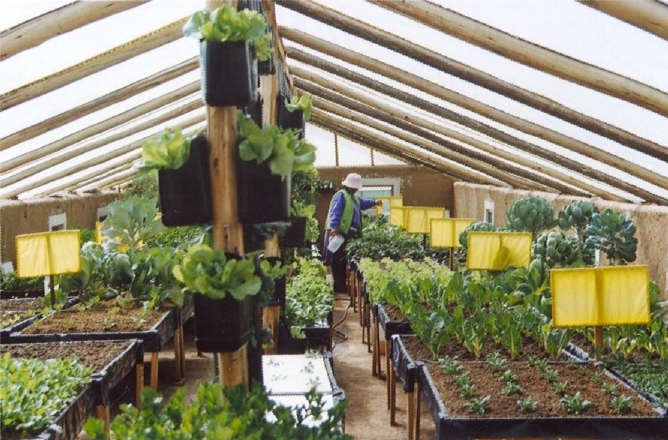Greenhouses: Difference between revisions
| Line 24: | Line 24: | ||
===Product Ecology=== | ===Product Ecology=== | ||
* [[ | * [[biochar]] to improve [[:Category:Soil and compost|soil]] | ||
* [[Aquaponics]], [[Integrated Food and Waste Management System]], [[Organoponic Raised Bed Gardening]], vermicompost, [[Black Soldier Fly]] | * [[Aquaponics]], [[Integrated Food and Waste Management System]], [[Organoponic Raised Bed Gardening]], vermicompost, [[Black Soldier Fly]] | ||
* CEBs for walls and stairs | * CEBs for walls and stairs | ||
Revision as of 20:38, 12 February 2011
Main > Food and Agriculture > Controlled-environment growing
Greenhouses are rooms that maximize natural light and can be used for controlled-environment growing. They may be stand-alone or part of a house. We aim to open source robust growing systems. This will empower people to grow high-value crops such as herbs - for self-sufficiency and for market.
Inflatable greenhouses
Nick says: Inflatable greenhouses such as this one would eliminate frame material and make for quick easy setup. The only trick would be creating a good seal around the air columns. Most greenhouse film is a UV resitant type of polyethylene and can be "welded". Here is a kit for $288. There may be better ways of doing but the concept seems to have potential.
Bob says check out pillow domes - a kind of geodesic dome devised by Jay Baldwin (a Bucky Fuller student) with Argon-inflated pillows of long lived UV transparent plastic (Tefzel). The concept was later applied on a much larger scale in the Eden Project.
Walipini/ Pit greenhouses
A greenhouse can be built by digging a hole in the ground and covering it with glass. This takes advantage of the heat stored in the earth during the cold season (warmth in winter, cooling in summer). It is an adaptation of the idea of passive annual heat storage (PAHS) to the greenhouse. Therefore very suitable for climates with cold winters. At the depth of several meters, there is very little seasonal variation in temperature. The earth around the greenhouse structure has large thermal mass.
Benson Institute
The Benson Agriculture and Food Institute at Brigham Young University examined the concept in detail and has put together a manual with specific designs (internal copy here). Their design costs $250-$300 in materials and is designed to provide vegetables year-round for seven people. They recommend a minimum of 94 square feet (less than 8.75m2) of growing space per person. This will provide vegetables year-round.
These underground greenhouses are called "Walipini" (pit greenhouse) in South America. The Benson Institute's experiment was built in Bolivia, high up in the Andes where it gets really cold.
Mike Oehler
Mike Oehler, of UndergroundHousing.com, described a similar concept in his 2007 book: The Earth-Sheltered Solar Greenhouse Book, available here. This is an adaptation from his earlier work on underground housing for residential purposes.
Product Ecology
- biochar to improve soil
- Aquaponics, Integrated Food and Waste Management System, Organoponic Raised Bed Gardening, vermicompost, Black Soldier Fly
- CEBs for walls and stairs
- compressed air for ventilation
- plastic extruder for films and pipes
Links
- UndergroundHousing.com [1]
- Wikipedia entry on Seasonal Thermal Store [2]
- Conversion of a swimming pool into a greenhouse.
Solar greenhouses
Solar greenhouses incorporate special design features to maximize use of the Sun's heat. The article Those Remarkable Bolivian Solarhouses from Maximum Yield magazine describes a UN project in Bolivia. Over 300 solarhouses were built. They cost $6/m2 (56c per square foot) and proved themselves capable of growing warm-climate vegetables throughout winter high in the Andes without heaters. The article gives detailed descriptions of how they are built.
FAO booklet
8. Solar house
8.1. The combined passive solar energy training building
8.2. The passive and active combined solar working office
9. Research on the temperature environment of solar greenhouse
9.1. The temperature simulation and structural optimization of the solar greenhouse
9.2. The underground heat exchange system of protected vegetable cultivation
9.3. The benefit of vegetable production in the underground heat exchange solar greenhouse
10. Integrated energy self-served animal and plant complementary ecosystem in China
10.1. Introduction (about CO2 enrichment)
10.2. History and principle of the integrated energy self-served animal and plant complementary producing system
10.3. The investigation of the problems of the integrated energy self-served ecosystem
10.4. The structure improvement of the energy self-served animal and plant complementary ecosystem
10.5. The study and test of the ventilation system in the E-W form of the ecosystem

